
Artists Among Us: Artist Profile – Steve Miller
By Eileen Casey
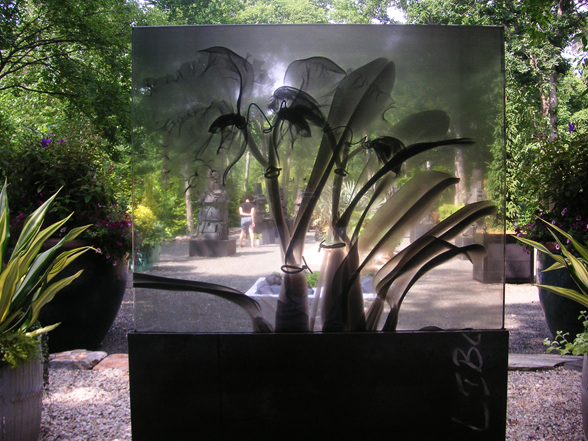
Health of the Planet" 2008, detail at LongHouse Reserve, glass and steel, 63 x 30. On view until mid-October.
Continuing with our artist profiles of artists both living and working in the Hamptons, our next artist is Steve Miller, who lives in Sagaponack.
Steve Miller was born in Buffalo where he lived until graduating from high school. He attended Middlebury College in Vermont. After college he lived for two years in Provincetown, MA where he was a fellow at the Fine Arts Work Center. From Provincetown, Miller relocated to New York City, where he teaches at the School of Visual Arts. Miller splits his time between NYC and his large converted potato barn that is his studio in Sagaponack.
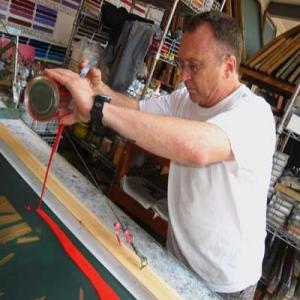
Artist Steve Miller in his Sagaponack Studio. All Photos by John Wilton
Miller’s 2001 show in New York entitled “Neolithic Quark” investigated particle physics in collaboration with Brookhaven National Labs using their Relativistic Heavy Ion Collider.
Recently, he investigated proteomics (defined as a branch of molecular biology concerned with protein sets in organisms) and bioinformatics (defined as the use of computer science, mathematics, and information theory to model and analyze biological systems, especially systems involving genetic material) working with Rod MacKinnon at Rockefeller University.
In September 2007, this work was presented in a solo exhibition at the Rose Art Museum at Brandeis University with a catalog entitled “Spiraling Inward” that accompanied the exhibition. The catalog contains essays by the Rose director, Michael Rush, anthropologist, Mark Auslander and Marvin Heiferman.
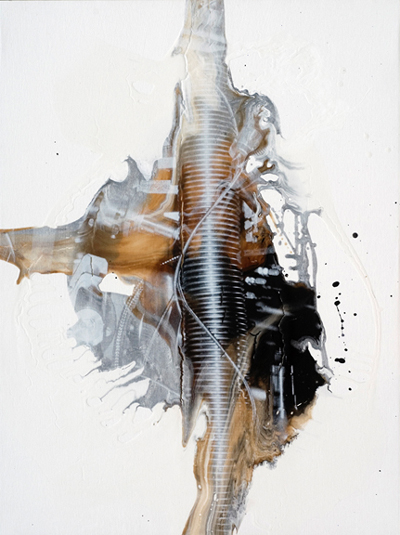
Liquid Fuel, 2008, dispersion and silkscreen on canvas, 39 x 29.5.
Miller has exhibited world-wide including solo exhibitions at White Columns, Artists Space, Public Art Fund-Times Square Electronic Billboard, CAPC Musee Bordeaux, Hong Kong Arts Center and Galerie Albert Benamou, Paris, and is represented by galleries in Paris, Munich, Basel, Bern, Buffalo and New York City.
When did you start making art and what medium(s) did or do you work in or consider to be your roots in art?
Steve Miller: The question is the “art” part. Most children, including myself, paint and draw from an early age. When is it art? Then when is it ‘good’ art? I’ll fall back on the Duchampian notion of context and when the action is perceived as art by the artist.
My interest in looking at art started as a teenager, spending hours at the Albright-Knox Art Gallery in Buffalo. My family had always dragged me to museums so they were a normal environment for me, but the first shocking experience was seeing Pollack’s “Convergence” for the first time. I think I was 12. That painting hung in a grand stairwell that you climbed in order to see the museum collection. It was an unavoidable confrontation. The scale, the freedom and the lack of a traditional image created a force field of energy. That was it.
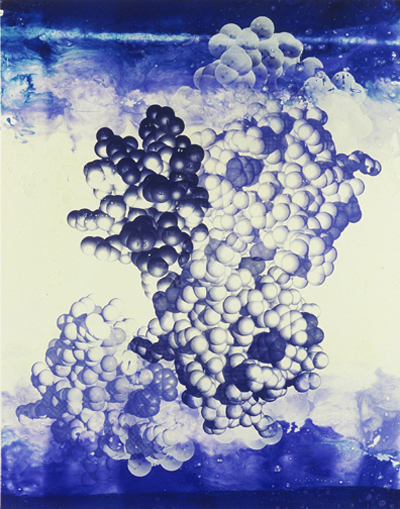
Soap Opera The Second Season, 2005, dispersion and silkscreen on canvas, 51 x 40.
To have the real stuff as a first-hand experience stayed with me forever. To this day, I look at art in galleries and museums on a weekly basis.
Naturally, at some point it was impossible to sit on the sidelines and watch. In my first week of college I walked out of a calculus class and a physics class (thinking I wanted to be an architect) and within 10 minutes took music and art classes instead. There were real artists teaching there and this made another deep impression. From that point on, I entertained the idea that this was a possibility, so the work I did from then on was the start of making art. I apprenticed myself to the sculptor, Ed Owre, and he taught me how to weld and chip marble. The physicality of that sculpture experience led me in that direction for a few years.
What is it about the Hamptons that brought you here and enticed you to stay, work, and pursue your art here as opposed to someplace else?
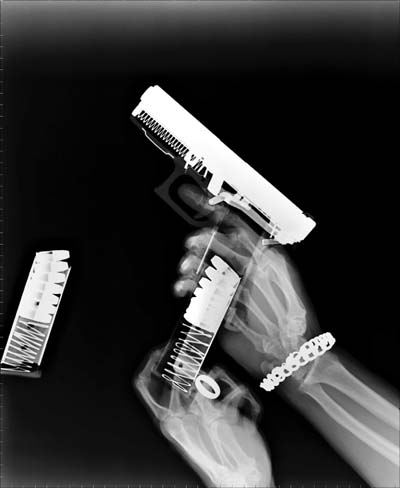
Glock. 2007. Iris print, 19.5 x 16, Courtesy of Laumont Editions.
How do you support yourself as an artist?
SM: There are as many survival stories as there are artists. Mine is ordinary in that I have done many jobs over the years to support my artwork including bartender, ski instructor, studio assistant, construction worker, house painter, and a commodities trader. That’s the short list. Today, selling artwork and teaching at the School of Visual Arts in New York is a more consistent flow than my previous life as a jack of all trades. Lately, working with a print publisher (www.laumont.com) has been helpful as well as a new edition at (www.healthoftheplanet.com). Prints are great because they are accessible to a larger audience.
Why live and work in the Hamptons as opposed to elsewhere?
SM: My time is divided between New York City and Long Island. There are great reasons to be in both places. The resources of New York and the space of nature are two things that I need to enjoy life.
What local environmental or historical aspects of the Hamptons do you relate to that may or may not be reflected in your medium?
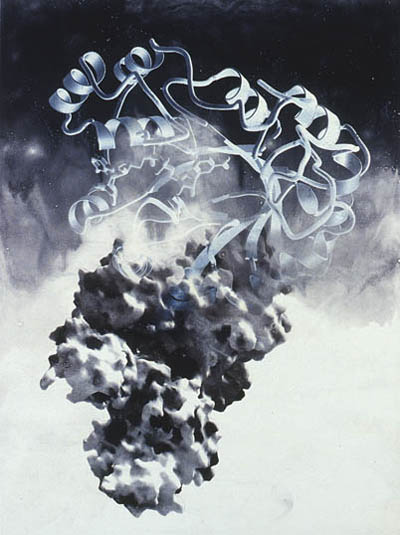
Signal Relay, 2003. dispersion and silkscreen on canvas, 50 x 37.5.
What artists do you feel have influenced you and or your work?
SM: The answer is always changing. It’s like asking what kind of music you like. I’ve always loved jazz and started out listening to Monk, Miles, and ‘Trane. Then I went through an intense Cuban phase where I couldn’t get beyond Chucho Valdes and Gonzalo Rubalcaba. Now it’s mostly Brazilian. It’s the same with art. My early exposure was the collection at the Albright-Knox Museum which has a solid collection of Abstract Expressionism and Pop. That work is still influential. Now art is so wide open with so much good art it’s impossible to make a list that means anything. I go blank thinking about it. Here is a random list of people I have not already mentioned who I admire and hope for their influence – Borgeois, Polke, Picabia, Prince, Mitchell, Minter, Heilman, Twombly, Goldstein, Bickerton, Orozco, Winters, and Wool. Recently, I discovered the American artist Chris Martin and the Brazilian artist Jarbas Lopes. I liked both their artwork so much that I bought work by each of them. The common quality that attracted me was a physical presence and tactile quality of their art. It would be great to be influenced by those qualities.
What advice would you give to an emerging artist?
SM: Look at as much art as possible. Read books. Be informed so you don’t have to unconsciously repeat what others have already done. Follow your instincts and think for yourself.
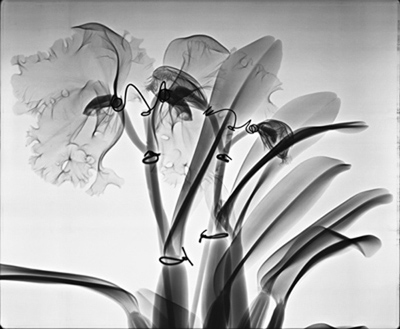
Glass, 2008. carbon on cotton, 24 x 29 (Part of Health of the Planet Series).
SM: If edge means a level of excitement or approaching a limit; a personal challenge can bring that edge into play. Sometimes it’s the pressure of a deadline or a problem to solve.
Last year a looming deadline for a solo museum show at the Rose Art Museum at Brandeis University in 2007 brought me to a new edge of energy and concentration. And this summer, I was asked to put a flower in a container at LongHouse Reserve that would last until October. Since I knew little about the kinds of plants that could survive in a container with minimal maintenance, I ultimately decided on something that did not use water. The result was an x-ray of an Amazon orchid printed on glass that sits vertically in a sheet of steel.
If edge means an advantage, for me that might mean access to technology that would be difficult for someone else to duplicate. I’ve had two projects instigated through a relationship with Brookhaven National Labs. The first project involved working with their particle accelerator, and that work was shown locally in an installation at the Parrish Art Museum in 2006 that can be viewed at www.stevemiller.com/installations.
The other project involved working with the BNL Synchrotron Light Source and meeting Robert Sweet who suggested I work with Rod MacKinnon in 2002. In the middle of that project in 2003, Rod was awarded the Nobel Prize in Chemistry. That timing led to the creation of a large body of work and ultimately resulted in an exhibition at the Rose Art Museum with a catalog that documented our collaboration.
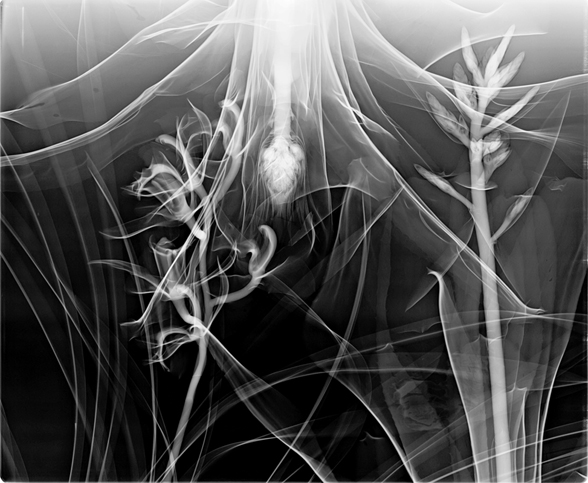
Jungle, 2008. carbon on cotton, 24 x 29 (Part of Health of the Planet Series).
What are you working on now, and are you involved in any upcoming shows or exhibitions?
SM: In the studio, I’m working on a project entitled “Health of the Planet,” which is about the rainforest in Brazil. The forests of the Amazon are the lungs of our planet. This project gives Brazil a medical check-up by taking x-rays of the plants and animals of the Amazon – this has allowed me to spend time in Brazil and study Portuguese. I was fortunate to work with a very good hospital in Sao Paulo to x-ray a large number of Amazon plants. I spent a week going to the enormous flower and fruit market on the outskirts of Sao Paulo, selecting Amazon material to take to the hospital. For a week I made digital x-rays of the plants. Eventually this will include paintings but the first phase of this exciting project is now complete and can be viewed on-line as a series of digital prints.
